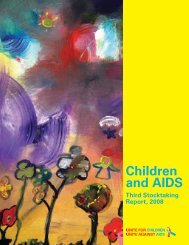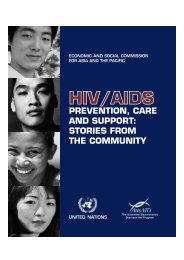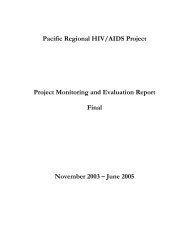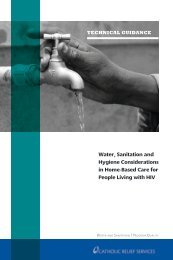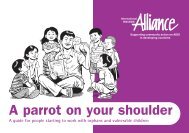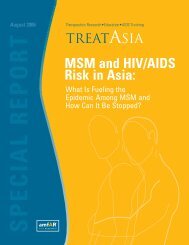Assessing HIV/AIDS Initiatives in China - Center for Strategic and ...
Assessing HIV/AIDS Initiatives in China - Center for Strategic and ...
Assessing HIV/AIDS Initiatives in China - Center for Strategic and ...
Create successful ePaper yourself
Turn your PDF publications into a flip-book with our unique Google optimized e-Paper software.
Bates Gill 29<br />
free lacks the proper f<strong>in</strong>ancial <strong>in</strong>centive <strong>for</strong> doctors <strong>and</strong> other health workers, particularly<br />
those <strong>in</strong> the more rural <strong>and</strong> remote parts of Ch<strong>in</strong>a who depend on charges <strong>for</strong> dispens<strong>in</strong>g<br />
drugs <strong>and</strong> other service fees <strong>for</strong> their livelihood.<br />
Third, the Ch<strong>in</strong>a CARES program so far has focused primarily on provid<strong>in</strong>g<br />
treatment to those persons who were <strong>in</strong>fected through illicit blood donor schemes <strong>in</strong><br />
central Ch<strong>in</strong>a. These persons were more readily identified <strong>and</strong> accessible by local health<br />
authorities, <strong>and</strong> many <strong>in</strong> this population had already progressed to <strong>AIDS</strong>. The vast<br />
majority of <strong>HIV</strong>-positive persons <strong>in</strong> Ch<strong>in</strong>a are, however, located <strong>in</strong> other prov<strong>in</strong>ces,<br />
particularly those where <strong>in</strong>travenous drug use is more widespread, especially <strong>in</strong> southern<br />
<strong>and</strong> western Ch<strong>in</strong>a: Yunnan, X<strong>in</strong>jiang, Guangxi, Sichuan, Guizhou, Hunan, Jiangxi, <strong>and</strong><br />
Guangdong. IDUs <strong>and</strong> CSWs present particular challenges <strong>for</strong> the national treatment<br />
program, as their activities, by their nature, make them less accessible <strong>and</strong> more reluctant<br />
to cooperate with government authorities. Some Ch<strong>in</strong>ese national treatment program<br />
officials also believe that IDUs <strong>in</strong> particular, because of their addiction <strong>and</strong> its effect on<br />
behavior, would be less reliable patients.<br />
Fourth, even where treatment is available, problems can arise. Monitor<strong>in</strong>g drug<br />
regimen adherence is a challenge as home-based treatment is the norm, <strong>and</strong> rural<br />
localities at the county <strong>and</strong> village levels lack the professional medical expertise <strong>and</strong><br />
equipment to assure proper treatment, adherence, <strong>and</strong> regimen adjustment. Moreover, the<br />
Ch<strong>in</strong>ese national treatment plan has only seven antiretroviral drugs available (there are<br />
over 20 such drugs available <strong>in</strong> the world). About 80 percent of Ch<strong>in</strong>a CARES patients<br />
receive a first-l<strong>in</strong>e treatment comb<strong>in</strong>ation—either AZT + ddI + neverap<strong>in</strong>e or d4T + ddI<br />
+ neverap<strong>in</strong>e—which is known to be less effective <strong>and</strong> generates severe side effects <strong>in</strong><br />
patients. As of mid-2006, Ch<strong>in</strong>a CARES does not provide second-l<strong>in</strong>e therapy when<br />
patients fail on their first-l<strong>in</strong>e treatments. These problems strongly suggest the likely<br />
emergence of drug-resistant <strong>HIV</strong> stra<strong>in</strong>s <strong>in</strong> Ch<strong>in</strong>a.<br />
In short, although the Ch<strong>in</strong>a CARES program is welcome <strong>and</strong> has made encourag<strong>in</strong>g<br />
progress, much more needs to be done. Now that Ch<strong>in</strong>a CARES is mov<strong>in</strong>g from an<br />
emergency response to a more st<strong>and</strong>ard treatment program, it will need to be more fully<br />
<strong>in</strong>tegrated <strong>in</strong>to the spectrum of patient management <strong>and</strong> l<strong>in</strong>ked closely with other<br />
components of a successful strategy, <strong>in</strong>clud<strong>in</strong>g prevention education <strong>and</strong> awareness, harm<br />
reduction, test<strong>in</strong>g, <strong>and</strong> other social services. This will require an even greater<br />
commitment of political will <strong>and</strong> f<strong>in</strong>ancial resources to solidify <strong>and</strong> build on the ga<strong>in</strong>s<br />
achieved thus far.<br />
Recommendations: Comprehensively Meet<strong>in</strong>g the<br />
Needs of At-risk Populations<br />
Given the <strong>HIV</strong>/<strong>AIDS</strong> situation <strong>in</strong> Ch<strong>in</strong>a, the persistent challenges that confront the fight<br />
aga<strong>in</strong>st the disease, <strong>and</strong> the emergent best practices <strong>in</strong> the country, the follow<strong>in</strong>g broad<br />
recommendations po<strong>in</strong>t to a promis<strong>in</strong>g way <strong>for</strong>ward.<br />
• GIVE PRIMARY FOCUS TO KEY MARGINALIZED AND AT-RISK POPULATIONS.<br />
Thus far, much of Ch<strong>in</strong>a’s government response to <strong>HIV</strong>/<strong>AIDS</strong> has focused on the<br />
plight of the rural villages <strong>and</strong> farmers that were so hard-hit by <strong>HIV</strong> as a result of the



